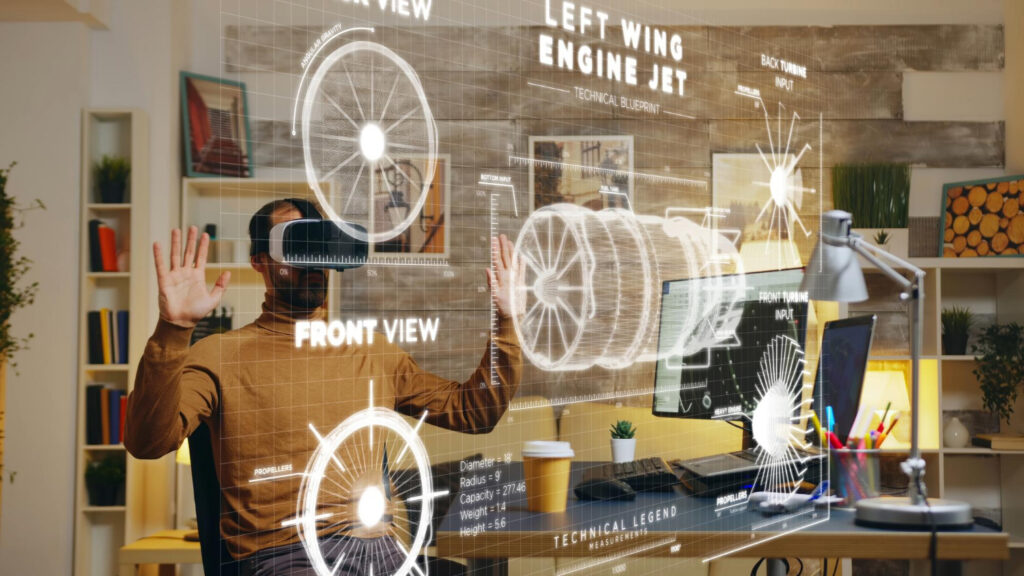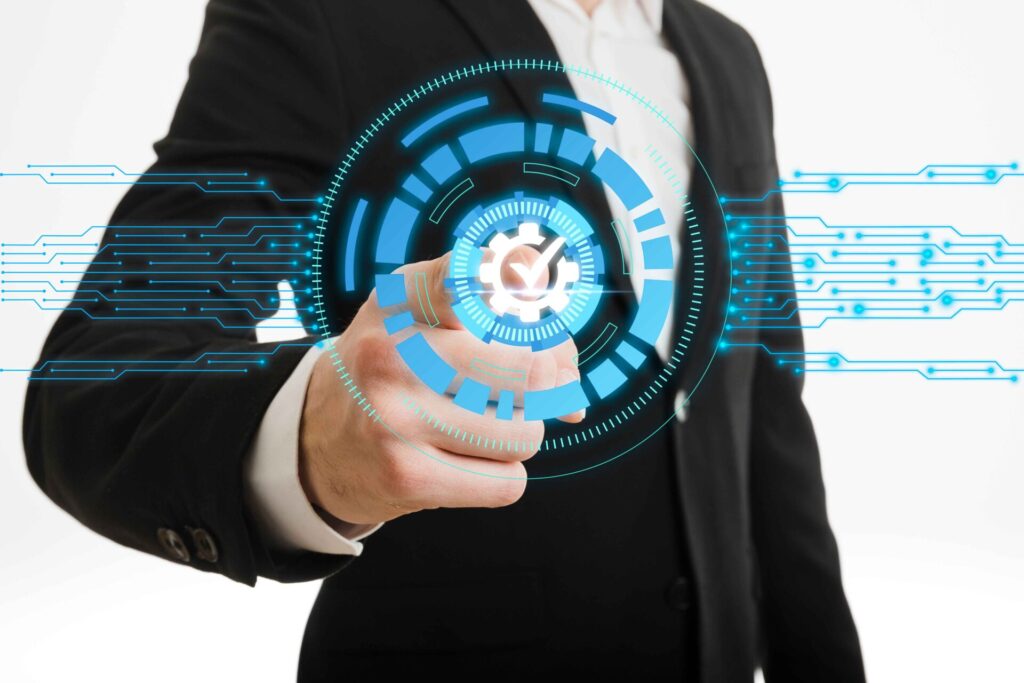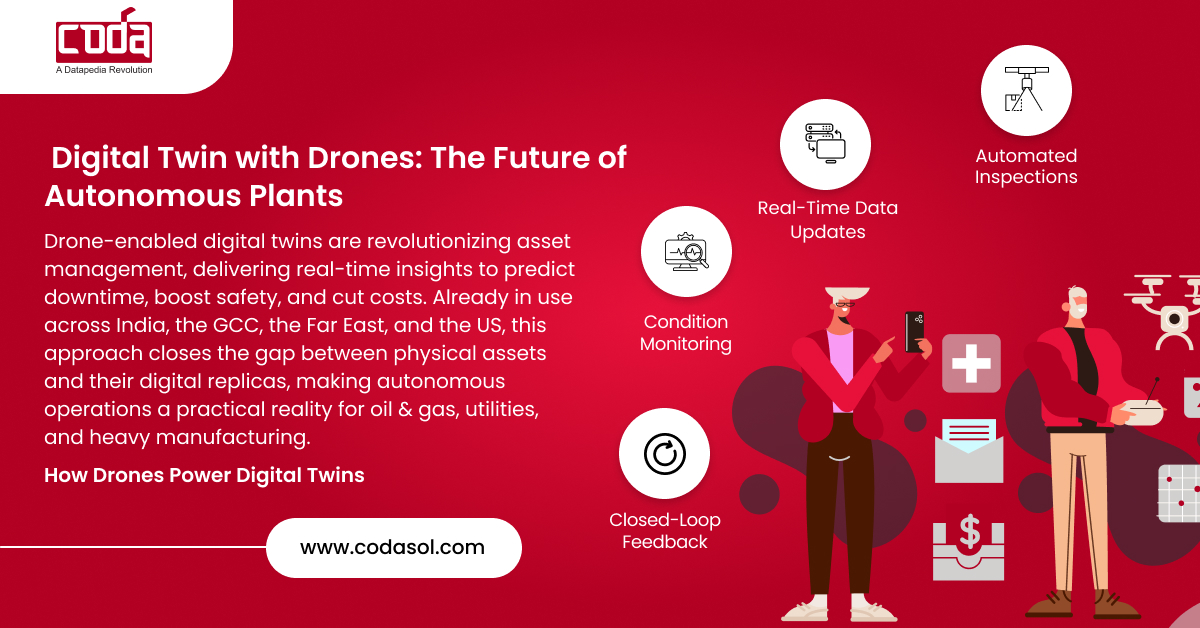Building the Feedback Loop with Digital Twins
Digital Twin with drones is transforming the way asset-intensive industries manage inspection, safety, and performance. By deploying drones to monitor pipelines, tanks, and stacks in real time, organizations can feed critical data directly into a digital twin—a dynamic replica of the plant that identifies corrosion, predicts downtime, and recommends safe, cost-effective repair strategies.
This capability is not a vision of the future. It is already being deployed across India, the GCC, the Far East, and the US. At its core is a single breakthrough idea: closing the feedback loop between the physical plant and its digital twin through drone-enabled data capture.
For leaders in oil & gas, utilities, and heavy manufacturing, the challenge is no longer about whether autonomous operations are possible. The real question is how quickly you can adopt them—and how to ensure clarity and control in an era of overwhelming data.
Data Without Feedback
Many enterprises already invest in plant digitalization, yet the payoff often falls short. Why?
- Sensors capture terabytes of data, but much of it is siloed.
- Manual inspections remain error-prone and unsafe.
- Engineering drawings quickly become outdated.
- Compliance teams struggle with fragmented logs.
Without a real-time feedback loop, digital twins are just static models—not dynamic assets. That’s where drones step in, acting as the eyes and ears of the autonomous plant.
How Drones Power Digital Twins
Drones bridge the last-mile gap between the physical world and digital systems. Unlike fixed IoT sensors, they move, adapt, and see what’s often invisible. Here’s how they fuel digital twins with drones:
- Automated Inspections
- Capture live video, thermal images, and LiDAR scans.
- Replace risky scaffolding inspections with safe aerial views.
- Real-Time Data Updates
- Drones upload captured visuals directly into asset management systems.
- Twins remain accurate even as equipment ages or changes.
- Condition Monitoring
- Thermal scans detect hot spots in transformers.
- Corrosion mapping predicts when pipelines need repair.
- Closed-Loop Feedback
- Maintenance logs and drone visuals sync with ERP/MDM systems.
- Digital twins no longer lag behind reality, they mirror it.
Why the Feedback Loop Matters
| Traditional Plants | Plants with Drones + Digital Twins |
|---|---|
| Manual, risky inspections | Safe, automated, aerial inspections |
| Outdated engineering drawings | Continuously updated digital replicas |
| Siloed, incomplete asset data | Unified golden record in MDM |
| Reactive maintenance | Predictive, data-driven decisions |
| Compliance burden | Built-in audit-ready documentation |
This shift isn’t just operational; it’s financial. Enterprises that build the drone-to-digital twin feedback loop consistently report:
- 30–50% lower inspection costs
- 20–40% faster project turnarounds
- Safer working conditions with fewer manual interventions
Case Study
A leading utility in the GCC recently deployed drones to inspect transmission towers across a 500 km grid. By feeding thermal images into its digital twin with drones, the utility was able to:
- Detect heat anomalies weeks before failure.
- Schedule preventive maintenance instead of emergency shutdowns.
- Save an estimated $4M annually in avoided downtime.
As their CTO put it:
“The drone-to-digital twin loop didn’t just give us visibility. It gave us foresight.”

Ready to see how drones can feed your digital twin in real time and get a roadmap for your autonomous plant journey.
Building Digital Twin with Drones: A Practical Guide
If you’re ready to move toward an autonomous plant, here’s how to start:
- Assess Your Current Digital Twin Maturity
- Do you already have CAD or 3D models of your assets?
- Are these integrated with ERP or MDM systems?
- Deploy Drones in Critical Areas
- Start with high-risk zones (flare stacks, offshore rigs, substations).
- Capture LiDAR, thermal, and photogrammetry data.
- Integrate with Master Data Management (MDM)
- Sync drone-captured data into a central “golden record.”
- Eliminate silos between engineering, compliance, and operations.
- Automate Feedback Loops
- Configure alerts when drone visuals show deviations from expected conditions.
- Push insights into ERP, maintenance, and compliance workflows.
- Scale to Predictive Operations
- Train AI/ML models on drone datasets.
- Enable self-healing recommendations in your plant systems.
Challenges and How to Overcome Them
- Data Overload: Drones generate huge files. A strong MDM layer ensures structured storage and governance.
- Integration Complexity: Many plants use multiple ERPs. Standardized APIs solve this challenge.
- Change Management: Teams may resist automation. Start with pilot projects that prove ROI fast.
That’s where Prosol, our flagship Master Data Management (MDM) platform, comes in. Prosol delivers structured storage, governance, and integration across all your enterprise systems, ensuring that your drone-driven digital twin works seamlessly, scales effectively, and drives measurable business value. Discover how Prosol can help you manage drone and digital twin data with confidence.
From Digital Twins to Autonomous Plants
Drones are not the end goal, they’re the enabler. When paired with robust digital twins and MDM systems, they unlock:
- Autonomous inspections
- Predictive maintenance at scale
- Lower OPEX and downtime
- Safer, smarter, compliance-ready operations
The autonomous plant of the future isn’t a distant vision. It begins with a drone flight today.
Explore how CODA can help you build, scale, and optimize your digital twin journey from drone-based data capture to real-time analytics and predictive decision-making.

FAQ: Digital Twins with Drones
1. What industries benefit most from drones in digital twins?
Oil & Gas, utilities, EPC, mining, and manufacturing see the biggest ROI due to asset complexity and safety risks.
2. Can drones replace traditional inspections entirely?
Not always, but they reduce up to 80% of manual inspections and improve worker safety dramatically.
3. How accurate are drone-based digital twins?
With LiDAR and photogrammetry, accuracy can reach sub-centimeter levels.
4. Do I need an existing digital twin to start?
No. Drones can create your first digital twin by scanning and modeling assets from scratch.
5. What about data security?
Enterprise-grade platforms ensure encrypted transfer, compliant storage, and role-based access.

